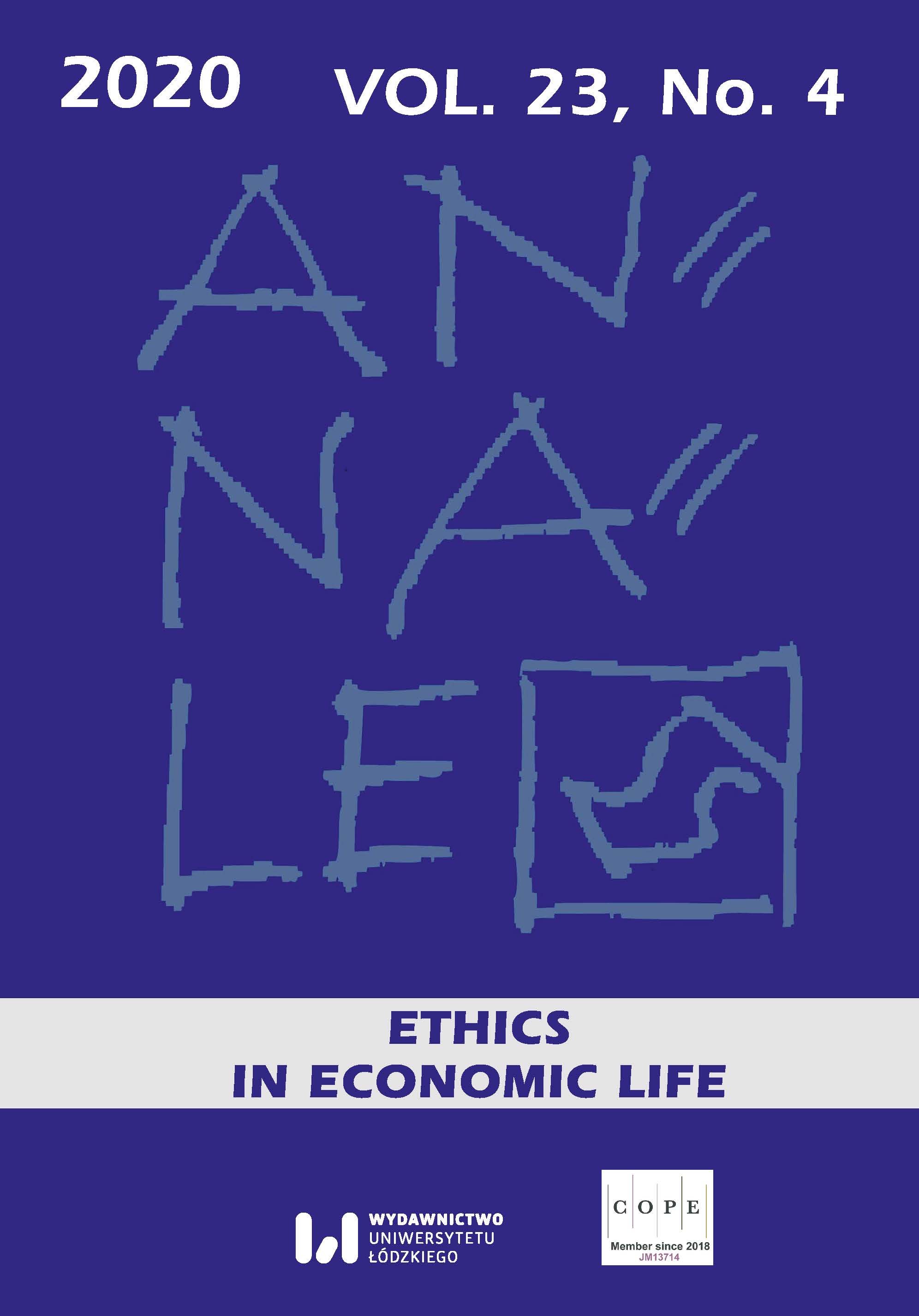Luka płacowa oparta na płci w przypadku kobiety na stanowiskach kierowniczych. Kraje Grupy Wyszechradzkiej w świetle sytuacji w Unii Europejskiej
DOI:
https://doi.org/10.18778/1899-2226.23.4.05Słowa kluczowe:
Gender, pay gap, women, V4, EUAbstrakt
This research investigates the level of the gender pay gap and gender parity in the Visegrad Group countries in light of the changes that took place in the whole EU during the last decade. The following hypotheses accompany the research objective: (1) the level of the gender pay gap diminished significantly over the last decade in the V4 economies; (2) the V4 countries are following a path to achieve gender parity. Data were taken from Eurostat. The pay gap and the managerial occupations indicators were used to verify the research hypotheses.
The empirical investigation did not let us reject the first hypothesis for Poland only. However, it should be rejected for the other V4 economies. In addition, the second hypothesis should be rejected.
Bibliografia
17 Goals to Transform Our World. (2020). United Nations. https://www.un.org/sustainabledevelopment/ (accessed: October 20, 2020).
Google Scholar
Adelekan, A. M. & Bussin, M. H. R. (2018). Gender Pay Gap in Salary Bands Among Employees in the Formal Sector of South Africa. SA Journal of Human Resource Management, 16, article a1018. https://doi.org/10.4102/sajhrm.v16i0.1018
Google Scholar
DOI: https://doi.org/10.4102/sajhrm.v16i0.1018
Aláez-Aller, R., Longás-García, J. C. & Ullibarri-Arce, M. (2011). Visualising Gender Wage Differences in the European Union. Gender, Work and Organization, 18(suppl. 1), e49-e87.
Google Scholar
Arulampalam, W., Booth, A. L. & Bryan, M. L. (2007). Is There a Glass Ceiling over Europe? Exploring the Gender Pay Gap across the Wage Distribution. Industrial and Labor Relations Review, 60(2), 163–186.
Google Scholar
DOI: https://doi.org/10.1177/001979390706000201
Bando, R. (2019). Evidence-Based Gender Equality Policy and Pay in Latin America and the Caribbean: Progress and Challenges. Latin American Economic Review, 28(1), 1–23.
Google Scholar
DOI: https://doi.org/10.1186/s40503-019-0075-3
Bayard, K., Hellerstein, J., Neumark, D. & Troske, K. (1999). New Evidence on Sex Segregation and Sex Difference in Wages from Matched Employee-Employer Data. NBER Working Paper, 7003.
Google Scholar
DOI: https://doi.org/10.3386/w7003
Becker, G. S. (1957). The Economics of Discrimination, 2nd ed. Chicago: University of Chicago Press.
Google Scholar
Becker, G. S. (1985). Human Capital, Effort, and the Sexual Division Labor. Journal of Labor Economics, 3(1), 33–58.
Google Scholar
DOI: https://doi.org/10.1086/298075
Bergmann, B. (1974). Occupational Segregation, Wages, and Profits when Employers Discriminate by Race or Sex. Eastern Economic Journal, 1(2), 103–110.
Google Scholar
Bhorat, H. & Goga, S. (2013). The Gender Wage Gap in Post-Apartheid South Africa: A Re-Examination. Journal of African Economies, 22(5), 827–848.
Google Scholar
DOI: https://doi.org/10.1093/jae/ejt008
Black, S. E. & Brainerd, E. (2004). Importing equality? The Impact of Globalization on Gender Discrimination. Industrial and Labor Relations Review, 57(4), 540–559. https://doi.org/10.1177%2F001979390405700404
Google Scholar
DOI: https://doi.org/10.1177/001979390405700404
Blau, F. D. (1977). Equal Pay in the Office. Lexington, MA: Lexington Books.
Google Scholar
Blau, F. D. & Kahn, L. M. (2007). The Gender Pay Gap: Have Women Gone as far as They Can? Academy of Management Perspectives, 21(1), 7–23.
Google Scholar
DOI: https://doi.org/10.5465/amp.2007.24286161
Dolado, J. J., García-Peñalosa, C. & Tarasonis, L. (2020). The Changing Nature of Gender Selection into Employment over the Great Recession. Economic Policy, 35(104), 635–677.
Google Scholar
DOI: https://doi.org/10.1093/epolic/eiaa025
Domańska, A., Żukowska, B. & Zajkowski, R. (2019). Sustainable Development versus Gender Gap – Do Women Matter? Problemy Ekorozwoju, 14(2), 129–142.
Google Scholar
Fadoš, M. & Bohdalová, M. (2019). Unemployment Gender Inequality: Evidence from the 27 European Union Countries. Eurasian Economic Review, 9(3), 349–371.
Google Scholar
DOI: https://doi.org/10.1007/s40822-018-0107-3
Galy-Badenas, F. & Croucher, S. M. (2016). Men and Women in Positions of Responsibility: A Qualitative Analysis of Organizational Readiness in France and Finland. Journal of Intercultural Communication, 41.
Google Scholar
Jakubowska, U. & Kaniasty, K. (2015). Predictors of Political Participation in Poland: Gender and Period Effects in the Context of Political Transformation. Československá Psychologie, 59(1), 79–90.
Google Scholar
Leythienne, D. & Ronkowski, P. (2018). A Decomposition of the Unadjusted Gender Pay Gap Using Structure of Earnings Survey Data. Luxembourg: Pub-lications Office of the European Union.
Google Scholar
Marcu, L. & Tănase, C. L. (2018). Employment Rate and Gender Employment Gap in Romania in the Context of Europe 2020 Strategy. Ovidius University Annals. Economic Sciences Series, 18(1), 92–97.
Google Scholar
Marilyn, B. & Olawale, O. (2017). Achieving the Millennium and Sustainable Development Goals in Africa: What Role for Female Social Workers. Gender and Behaviour, 15(2), 9088–9100.
Google Scholar
Maume, D. J., Heymann, O. & Ruppanner, L. (2019). National Board Quotas and the Gender Pay Gap among European Managers. Work, Employment and Society, 33(6), 1002–1019.
Google Scholar
DOI: https://doi.org/10.1177/0950017019864509
Norrander, B. (1999). The Evolution of The Gender Gap. Public Opinion Quarterly, 63(4), 566–576.
Google Scholar
DOI: https://doi.org/10.1086/297871
North, A. (2010). MDG 3 and the Negotiation of Gender in International Education Organisations. Compare: A Journal of Comparative & International Education, 40(4), 425–440. https://doi.org/10.1080/03057925.2010.490363
Google Scholar
DOI: https://doi.org/10.1080/03057925.2010.490363
Oczki, J. (2016). Gender Pay Gap in Poland. Ekonomia Międzynarodowa, 14, 106–113. https://doi.org/10.18778/2082-4440.14.01
Google Scholar
DOI: https://doi.org/10.18778/2082-4440.14.01
Ofisi, M. & Lukamba, M. T. (2020). Closing the Gender Gap through ICT in Small Scale Farming: Towards Achieving Sustainable Development Goals. Gender and Behaviour, 18(4), 16687–16697.
Google Scholar
Srinivas, S. (2007). Social Attitudes and the Gender Pay Gap in the USA in Recent Years. International Journal of Social Economics, 34(4), 268–275. https://doi.org/10.1108/03068290710734226
Google Scholar
DOI: https://doi.org/10.1108/03068290710734226
The gender pay gap situation in the EU. (2020). European Commission. https://ec.europa.eu/info/policies/justice-and-fundamental-rights/gender-equality/equal-pay/gender-pay-gap-situation-eu_en (accessed: October 25, 2020).
Google Scholar
van Mensvoort, C., Kraaykamp, G., Meuleman, R. & van den Brink, M. (2020). A Cross-Country Comparison of Gender Traditionalism in Business Leadership: How Supportive Are Female Supervisors? Work, Employment and Society, 35(4), 793–814.
Google Scholar
DOI: https://doi.org/10.1177/0950017019892831
Women remain outnumbered in management. (2020). Eurostat, March 3. https://ec.europa.eu/eurostat/web/products-eurostat-news/-/edn-20210305-2 (accessed: October 25, 2020)
Google Scholar
Zawisza, M., Luyt, R. & Zawadzka, A. (2012). Ambivalence Toward Men: Comparing Sexism Among Polish, South African and British University Students. Sex Roles, 66(7–8), 453–467.
Google Scholar
DOI: https://doi.org/10.1007/s11199-011-0112-4
Pobrania
Opublikowane
Jak cytować
Numer
Dział
Licencja

Utwór dostępny jest na licencji Creative Commons Uznanie autorstwa – Użycie niekomercyjne – Bez utworów zależnych 4.0 Międzynarodowe.









